SEO stands for Search Engine Optimization. It is the part of digital marketing that deals purely with improving the visibility of your website on search engines such as Google.
This makes it an essential digital marketing strategy in which the content and structure, but also external factors over which you have less direct influence, such as backlinks to your website, are adjusted and optimized with the aim of increasing your organic position in the search engines and thus visitor numbers from search engines.
This guide will detail the different components so you can learn everything you need about SEO.
Table of Contents
- What is SEO?
- Why is SEO important?
- #1 SEO brings free visitors to your website
- #2 Fewer and fewer people are clicking on ads
- #3 SEO also strengthens your other channels
- #4 Search engine optimization helps with building trust and credibility
- #5 Local SEO gives opportunities to build offline visitors and customers
- #6 With SEO, reach customers even before they have made their buying decision
- #7 SEO is essential for the long-term growth of your business
- #8 With SEO, you will discover important new opportunities
- #9 Search engine optimization reduces dependence on other channels
- SEO statistics
- What is the difference between SEO and content marketing
- How do search engines work?
- What types of search engine optimizations are there?
- Keyword research
- What is the importance of keywords for SEO?
- How to conduct keyword research?
- Tips for selecting the right keywords
- How to get started with on-page SEO optimization
- Optimize title tags and meta descriptions
- URL structure optimization
- Optimizing headlines
- Content optimization
- Optimize internal linking
- How to get started with off-page SEO optimization
- How to get started with technical SEO optimization
- What tools do you need and can you use for search engine optimization?
- Ubersuggest
- Answer The Public
- Screaming Frog
- Google Analytics
- Google Search Console
- Google Tag Manager
- Google Business Profiles (or formerly known as Google My Business)
- RankMath or Yoast SEO (for WordPress)
- Frequently asked questions about SEO
- How much does SEO cost?
- What will SEO bring me?
- How long does it take to see results from my SEO efforts?
- What are the main components of search engine optimization?
- What are "white-hat" and "black-hat" SEO?
- Should I hire an SEO specialist, consultant, or agency?
- Getting started with SEO yourself?
What is SEO?
SEO is a term that most who are involved in digital marketing have heard of and have in the back of their minds. From CMO to copywriter to webdeveloper. Everyone knows something about it, but what does it really mean?
SEO, or Search Engine Optimization, is a collection of different techniques to ensure that search engines can better understand your website and assess the value of your website content.
After all, search engines aim to provide the best possible answers to the problems people are searching for.
So if Google and other search engines can better understand the content of your website, they can award you a better position on the search engine results page (or SERP for short).
Your primary focus should not be on search engines; ultimately, the content you create is aimed at people. And so, making sure that your answer is as straightforward as possible to get people to solve their problems quickly is still THE main focus you will need to have.
So as an SEO specialist, you have to take quite a few things into account, from writing good SEO texts aimed at the end user to technical aspects like making sure your website is readable on mobile, and it doesn’t take minutes for the content to show up.
Some other commonly used terms for SEO are: simply search optimization, natural search, organic ranking, etc.
Why is SEO important?
Probably by now, you are slowly beginning to see why SEO is important for your company’s digital marketing.
Of course, the most commonly given answer to this question is that people very much like attracting free website visitors. But did you know that there are other reasons why SEO is important for your marketing?
#1 SEO brings free visitors to your website
Free is obviously a slightly broad term because an empty website still does not attract visitors.
But if you invest in the right SEO specialist to help you, and you follow the tips in this and other guides on our website on doing keyword research, creating content for the different stages in the customer journey, etc., then SEO remains a very attractive financial option to grow your business.
Everything you invest now, will bring you new visitors for years to come, something you can’t say about Google Ads, Bing Ads, or any advertising platform.
Once you turn off the advertising tap, visitor numbers also dry up.
#2 Fewer and fewer people are clicking on ads
Sure, ads are also an essential part of any digital marketing strategy. And there are still a lot of people who click on the top (usually paying) results in search engines. Sometimes people don’t even realize they’ve clicked on an ad.
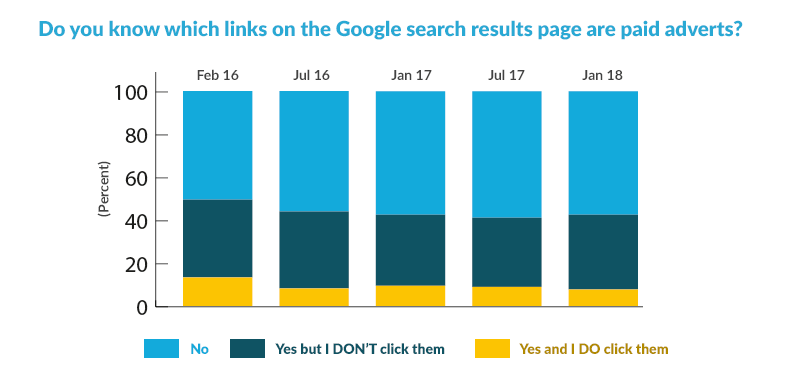
But that is changing considerably. People are becoming increasingly aware that there are ads at the top of search results and that companies have paid for them, while the results below them are there because they provide the best answer to the question.
You can see this in research from Semrush; organic search results still provide the most significant percentage click-through rate on both mobile and desktop.
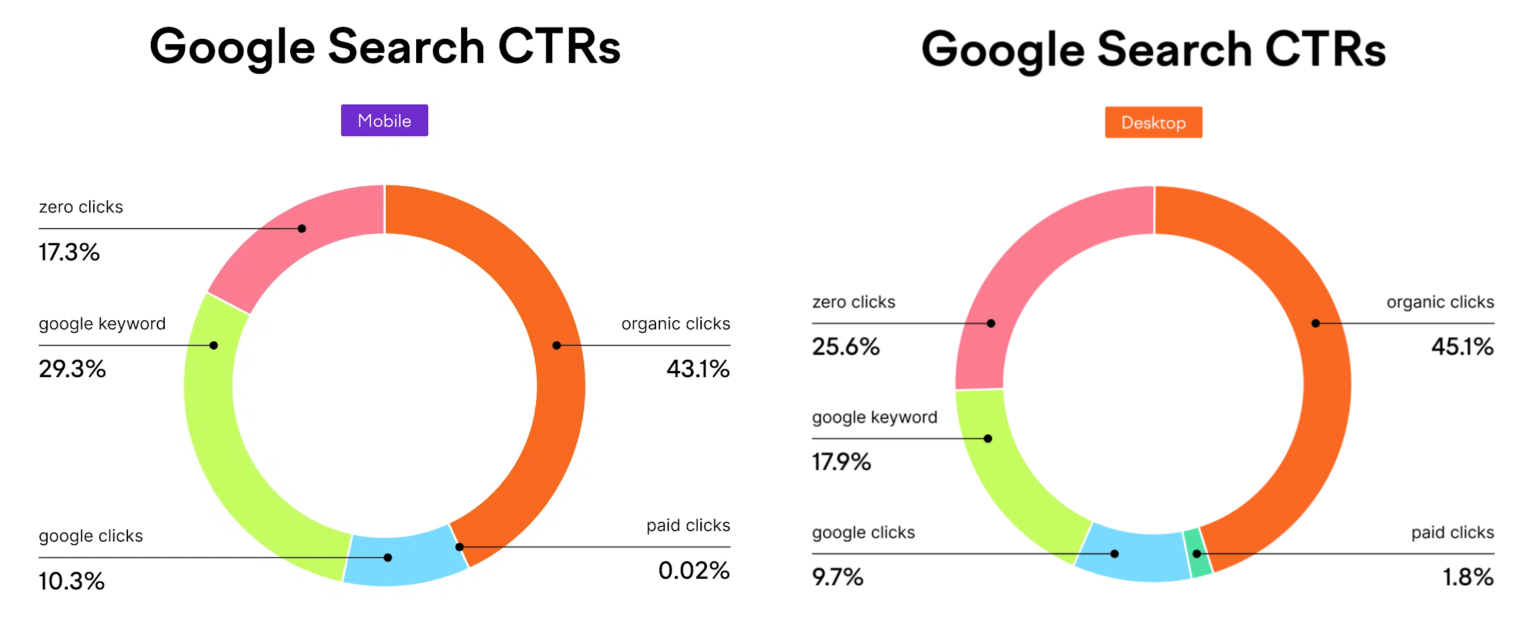
So depending only on ads is less and less effective.
#3 SEO also strengthens your other channels
SEO is not a separate pillar that doesn’t impact your other marketing efforts. One of the biggest benefits of doing search engine optimization for your business is that the steps you take also have a positive effect on the actions on your other channels.
- SEO strengthens your SEA
- SEO helps create target audiences for remarketing
- SEO contributes to better conversion because the engagement of your organic visitors is often much better than from paid channels. For example, organic visitors visit more pages, and the time they spend on those pages is a lot longer
- SEO helps improve the relevance you need to lower the Cost per Action (CPA) or Cost per Sale (CPS) of Search Engine Advertising (SEA)
- Technical SEO items like Core Web Vitals, also increase your page speed which again for conversion optimization is essential
#4 Search engine optimization helps with building trust and credibility
In fact, when you actively engage in SEO, you optimize your website and its content for the user step by step.
And when you provide visitors to your website with the right answer, the best solution for their search intent, you automatically build more trust.
Who would you be more likely to ask for advice? That handyman company that appears at the top of search results because of the quality of their website, that provides clear explanations of their plan of action, the materials they use, etc., or a company that had to buy their spot at the top?
As we pointed out in the second point, more and more people are deliberately scrolling past the paid ads and clicking on the organic search results.
What would this mean for your brand if you ranked number one?
#5 Local SEO gives opportunities to build offline visitors and customers
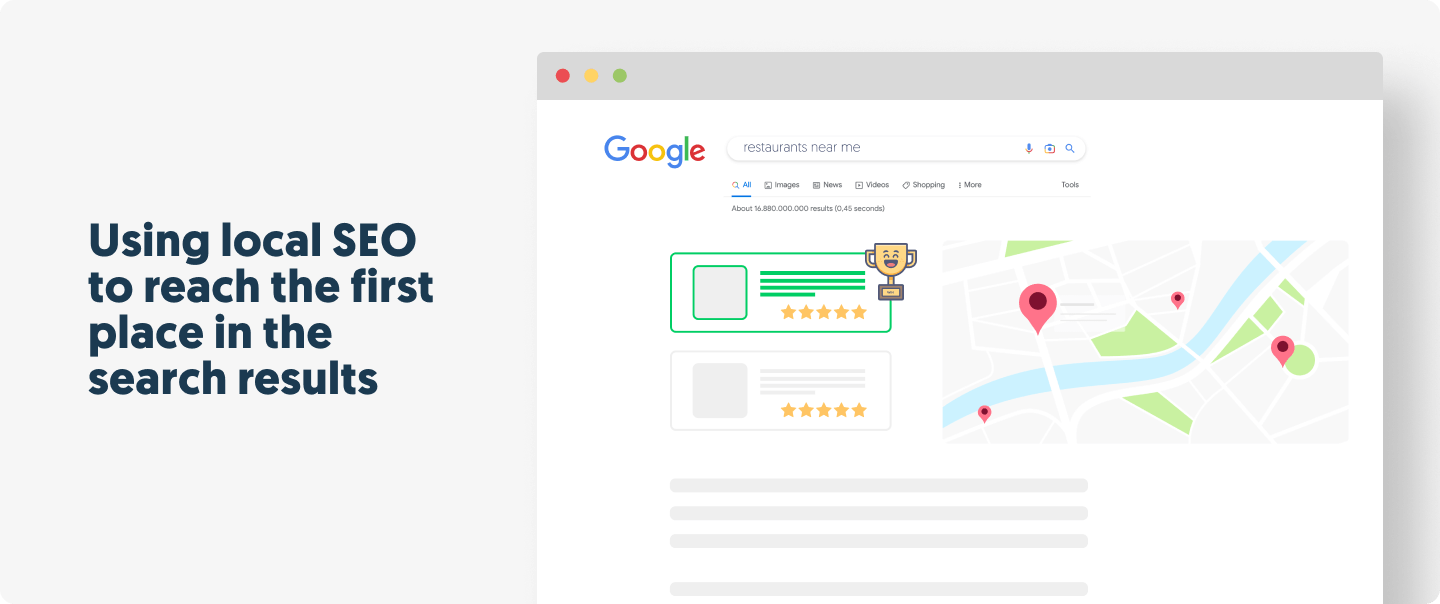
SEO can not only attract visitors for an online-only business, but if done correctly, it can also bring many visitors to local businesses. To your physical store or company itself!
This is called local SEO, and it is becoming increasingly important for smaller, local businesses. In fact, with local SEO, you can not only rank first in regular search results but also be number one in places like Google Maps for local searches like “restaurant near me.”
Small businesses and even larger businesses with multiple locations can benefit from this. As long as you have a physical location where you can receive customers or physically go from your business to your customers, then you can create a Google Business Profile.
Someone near your business can turn into a customer, and with your outstanding service, you can also turn them into repeat customers or such big fans that they tell all their acquaintances.
In fact, it is easier for some companies to make a massive impression through personal contact.
#6 With SEO, reach customers even before they have made their buying decision
Before people decide to buy a product or service, they usually research first, sometimes even before they know that a particular problem can actually be solved much easier with your product or service.
Advertisements usually focus on that very last step because it is generally only worthwhile to persuade someone to pay once they actually intend to purchase something.
It may even be the case that, at that point, you are actually too late because people already know what they want to purchase very well.
You can get in their minds much earlier in decision-making by using in-depth content and search engine optimization techniques.
By making people go through all the steps in the customer journey through content, there is a much greater chance that when they want to proceed to purchase a product or service to solve their problem, they will automatically come to you without having to look for any competitor.
#7 SEO is essential for the long-term growth of your business
We mentioned it already in the first point. All your SEO investments now will pay off for years to come.
With ads, you pay for every click that brings people to your website. Do you want more leads? Open up your wallet and start spending more money.
And even if it takes a little longer before you can see results from all your SEO efforts, every position you climb up in search results is one that immediately brings you many more visitors.
Just look at the difference between how many clicks number one and number two in organic search results get in this study by Sistrix:
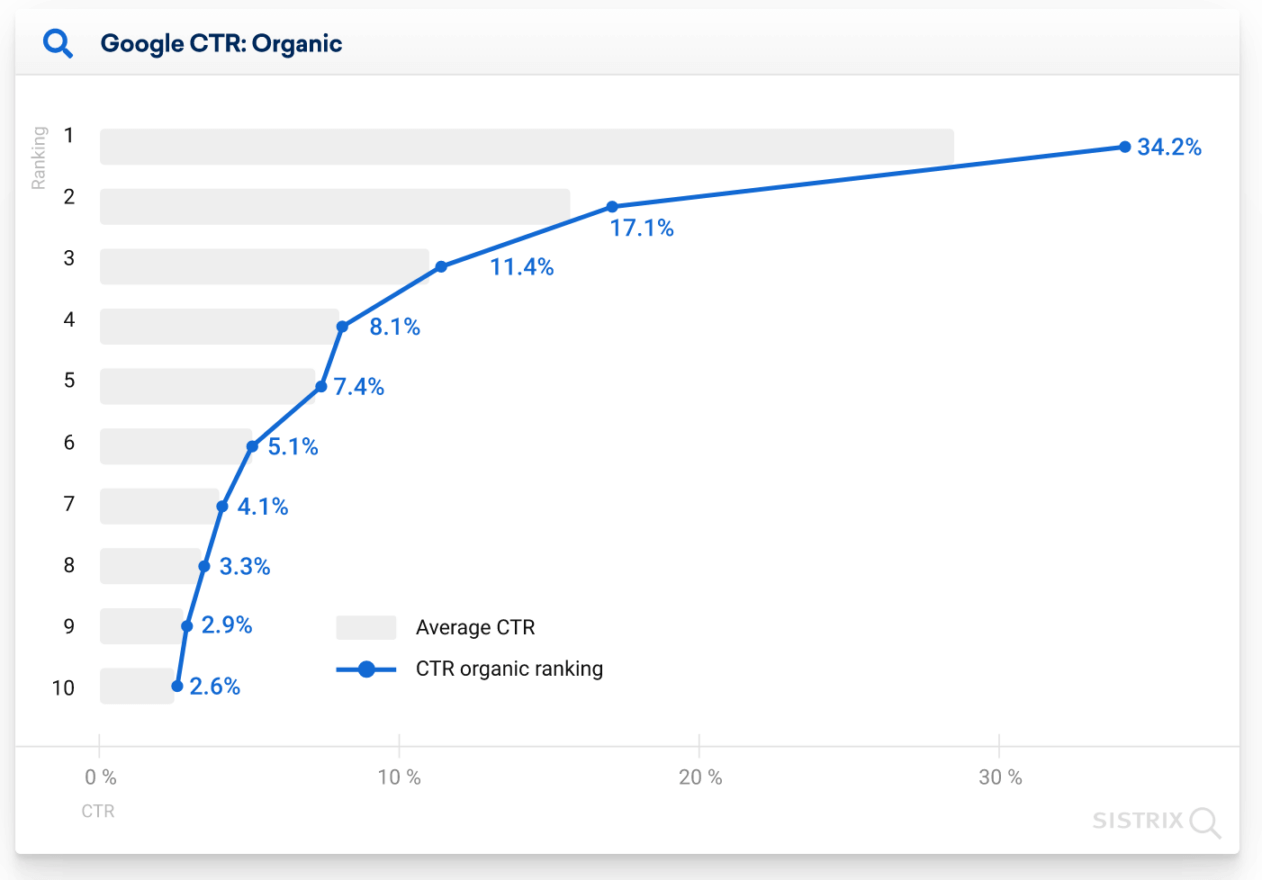
And the best part of all this? If you’re doing SEO well? Once you have that higher position in search results, you’ll keep attracting visitors.
And your next investment only builds on the success you already achieved and ensures that you are even further to get high in search results and attract more visitors.
#8 With SEO, you will discover important new opportunities
Once you start getting found online better, tools like Google Search Console allow you to see the words you’re being found for that you already knew and the words you probably haven’t even thought of yourself yet.
Of course, for these words, you won’t be found in the first place in the search engines right away.
But by using those extra keywords for the content on your website, you will be found more and more, which in turn brings in more opportunities to be found for your target audience.
#9 Search engine optimization reduces dependence on other channels
Everyone knows putting all your eggs in one basket is not a good idea. So why should you do so for marketing your business?
SEO is an accessible channel to start without making significant investments immediately. As a result, you can ensure your marketing channel mix becomes much healthier.
SEO statistics
Still not well convinced of the importance of SEO? Let’s give you some more statistics that further illustrate the importance of search engine optimization:
- 61% of CMOs see search engines as an effective marketing channel (source: Adweek)
- 49% of marketers cite organic search as the channel with the highest ROI (source: Search Engine Journal)
- 40% of revenue comes from organic traffic (source: semgeeks)
- SEO generates 1000% more traffic than social media (source: brightedge)
- 90% of B2B researchers online use search specifically to research business purchases. (source: Think With Google)
- 71% of B2B purchases begin their research with generic Google searches (source: Think With Google)
- On average, B2B researchers do 12 searches before visiting a particular brand’s site. (source: Think With Google)
- 70% of online marketers believe SEO is better than Pay Per Click (PPC) for generating sales. (source: Gitnux)
What is the difference between SEO and content marketing
One last thing before we dive into how SEO works. Search engine optimization and content marketing are terms that are often used interchangeably.
Yet it is important to know that they are not the same thing.
In fact, SEO focuses on only one part of content marketing: improving your website’s ranking in search engines such as Google.
Conversely, content marketing focuses on many more things, namely increasing the company or person’s authority, image, and conversions through channels other than search engines (such as social media or email marketing).
How do search engines work?
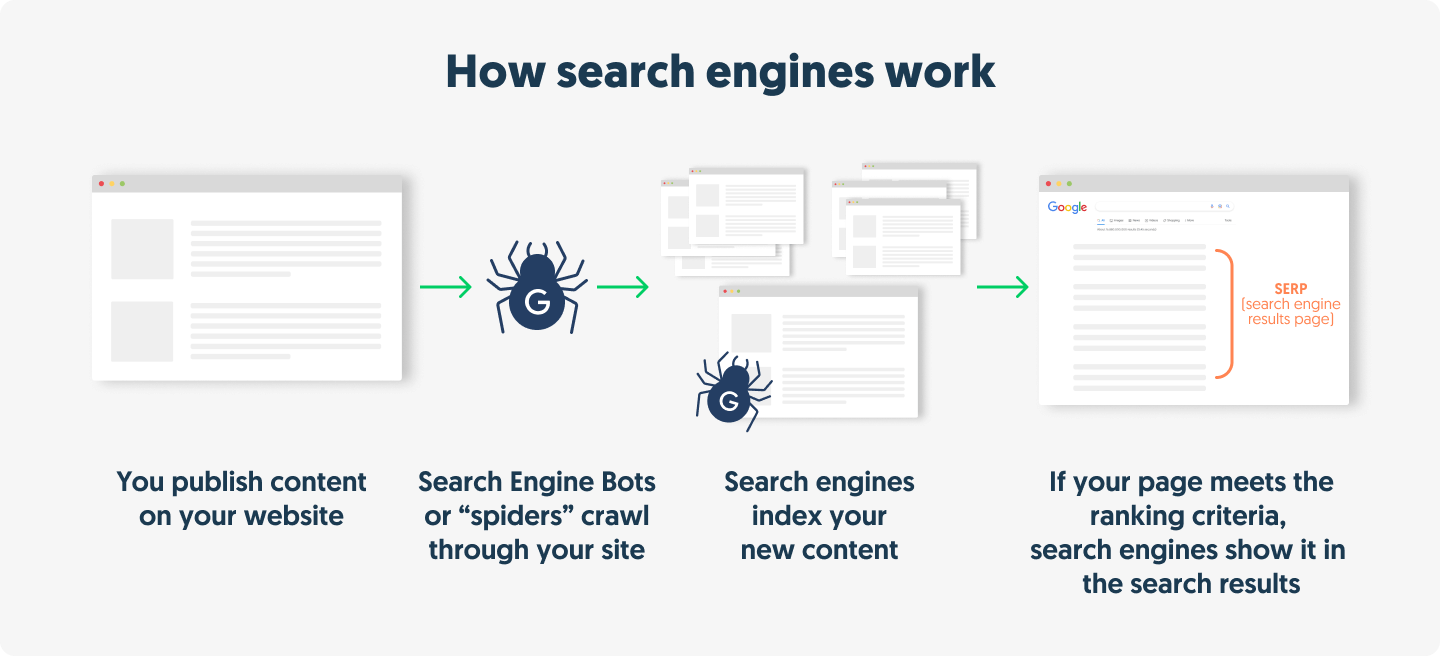
Okay, you understand the importance of SEO. You know the difference between SEO and content marketing. Now let’s see how search engines work, so you know what you’re up against..
Roughly speaking, the way search engines work can be divided into three parts:
- Crawling: every day, a massive pile of new websites and pages are created on the Internet. Googlebot, Bingbot, and other search engines “bots” crawl. They search through those new pages using search engine software on all websites. And because your website uses links, the crawler can quickly move from one page to another on your website and discover that new content.
- Indexing: After such a bot crawls your website, it will analyze, sort, and store those URLs in the search engine’s index (database). At this point, the crawler also tries to find out exactly what your content is about and what search query intent is connected to it.
- Ranking: The final step is ranking. In other words, the search engine ranks the pieces of content that best answer a searcher’s query, which means organizing the results from most relevant to least relevant.
Many people think of SEO only in terms of the latter. Ranking.
So the problem with the question “how does SEO work?” is that it’s a question you can’t answer that easily.
After all, a vast number of factors cause a search engine to determine who ranks number one ultimately, AND no one knows with 100% certainty what those factors all are.
They are secret. If they were known, everyone would do the same “trick,” and then there would be no difference between your company and your competitor.
Now Yandex’s algorithms were recently made public through a hack, where the 1922 ranking factors were shared on the Internet. And because Yandex started as a clone of Google by some ex-employees, there is some overlap, but with certainty, it can never be said what is REALLY important.
Also, not all factors you can directly influence, but fortunately, there are many factors you can control. Factors that were discovered after years of experimentation.
As you can see, determining which spot your website deserves in the SERP is only the final step for search engines.
What types of search engine optimizations are there?
So, as mentioned above, Google, Bing, and other search engines ensure that the actual ranking factors are not shared with the outside world. But through research, testing, and the sporadic official statements that do get shared, we can get a reasonable idea of what is really considered important.
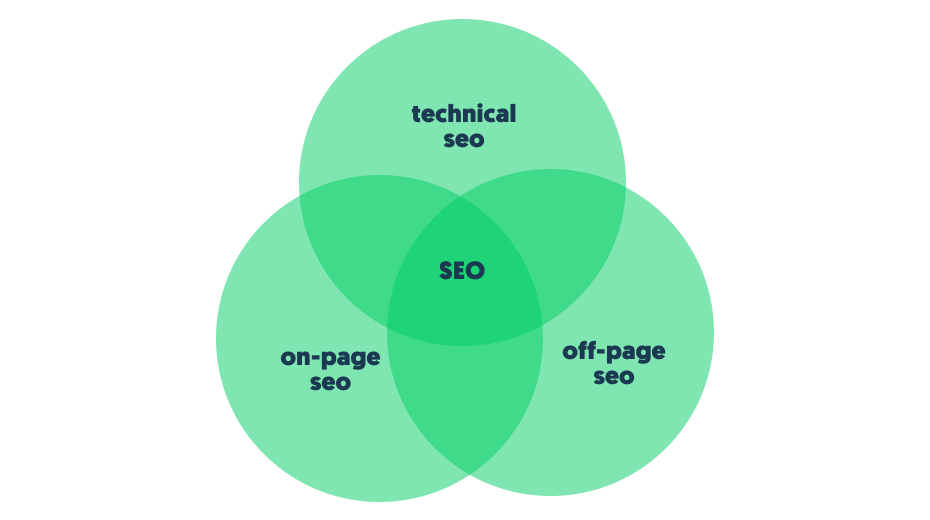
Roughly speaking, there are three main pillars:
- On-page SEO (aka content)
- Off-page SEO (aka the authority of your business/website)
- Technical SEO
On-Page Optimization
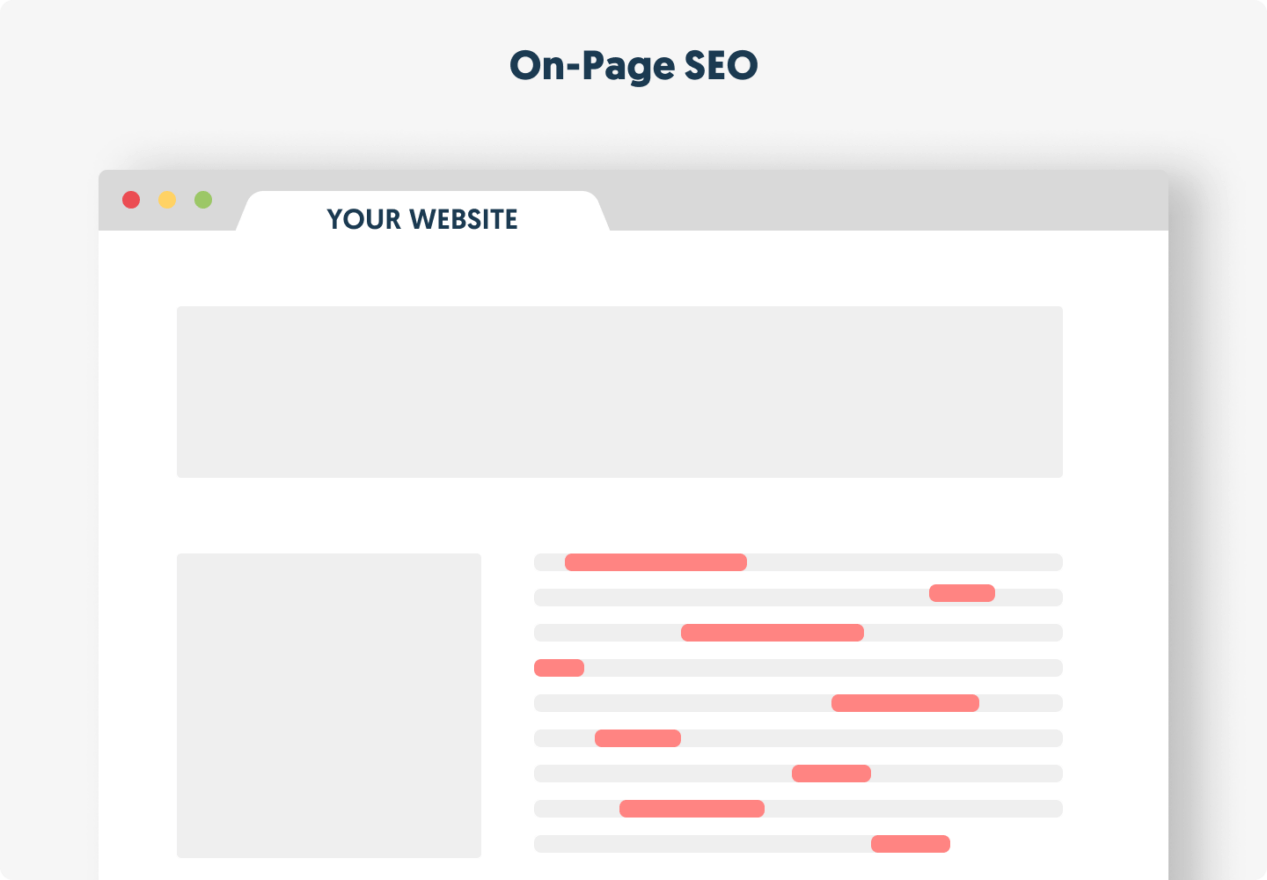
On-page SEO optimization usually refers to the content of your website where you are going to optimize your content to the different stages of the customer journey.
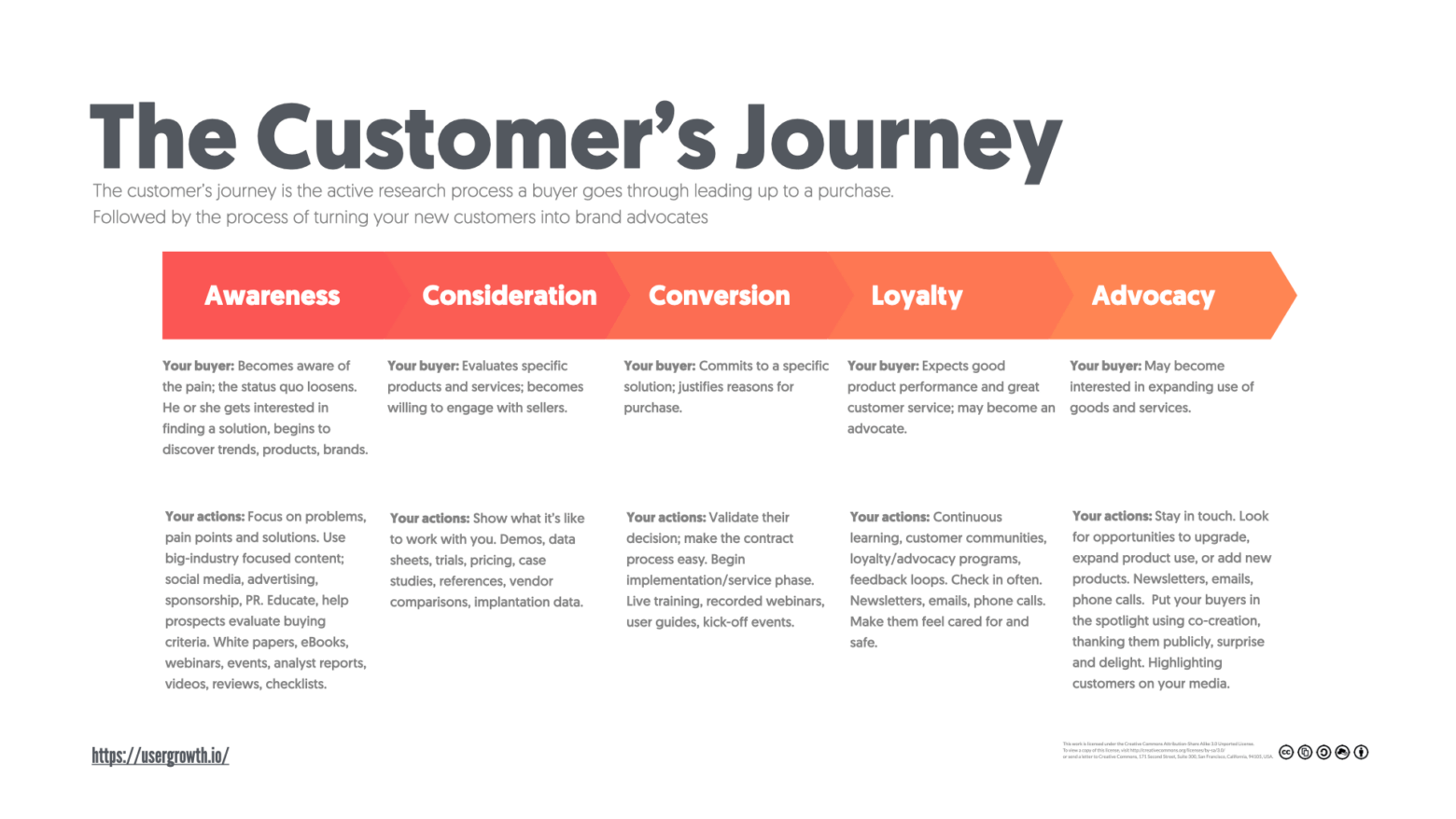
But on-page search engine optimization is more than just pure content. On-page SEO optimization is about improving individual web pages to ensure that their visibility in the SERP goes up. It’s about optimizing the content and structure of your website so that they become more accessible to users AND search engines.
Commonly used on-page SEO techniques are:
- Keyword research or keyword research. The basis of all content you create. After all, if you don’t correctly determine what keywords your pages want to be found for before you start writing them, then you’re just throwing spaghetti at the wall, hoping something will stick. So, keyword research. What are the right keywords for which your company wants to be found? And then which page with what content best plays into the needs of the person searching?
- Title tags: Title tags are HTML elements that describe the title of a Web page. They appear in search results as the clickable headline for a particular search result. Optimizing your title tags with relevant keywords can improve your website’s click-through rate (CTR) and position in search results.
- Meta-descriptions: A meta description is a web page summary that appears in search results below the title tag. Although meta descriptions do not directly affect search results, they can affect the CTR of a result by providing additional information about the content of a webpage.
- Header tags or headers: Header tags (H1, H2, H3, etc.) are HTML elements used to structure the content of a Web page. Using header tags to organize your content can make it easier for search engines to understand the structure of your Web page.
- Content optimization: Optimizing the content of your pages includes using relevant keywords in your content, using internal and external links to provide context and additional information, and making sure your content is engaging and valuable to users.
With these on-page optimization techniques, you can improve your website’s visibility and ranking in search results and attract more traffic and customers to your site.
Off-page Optimization
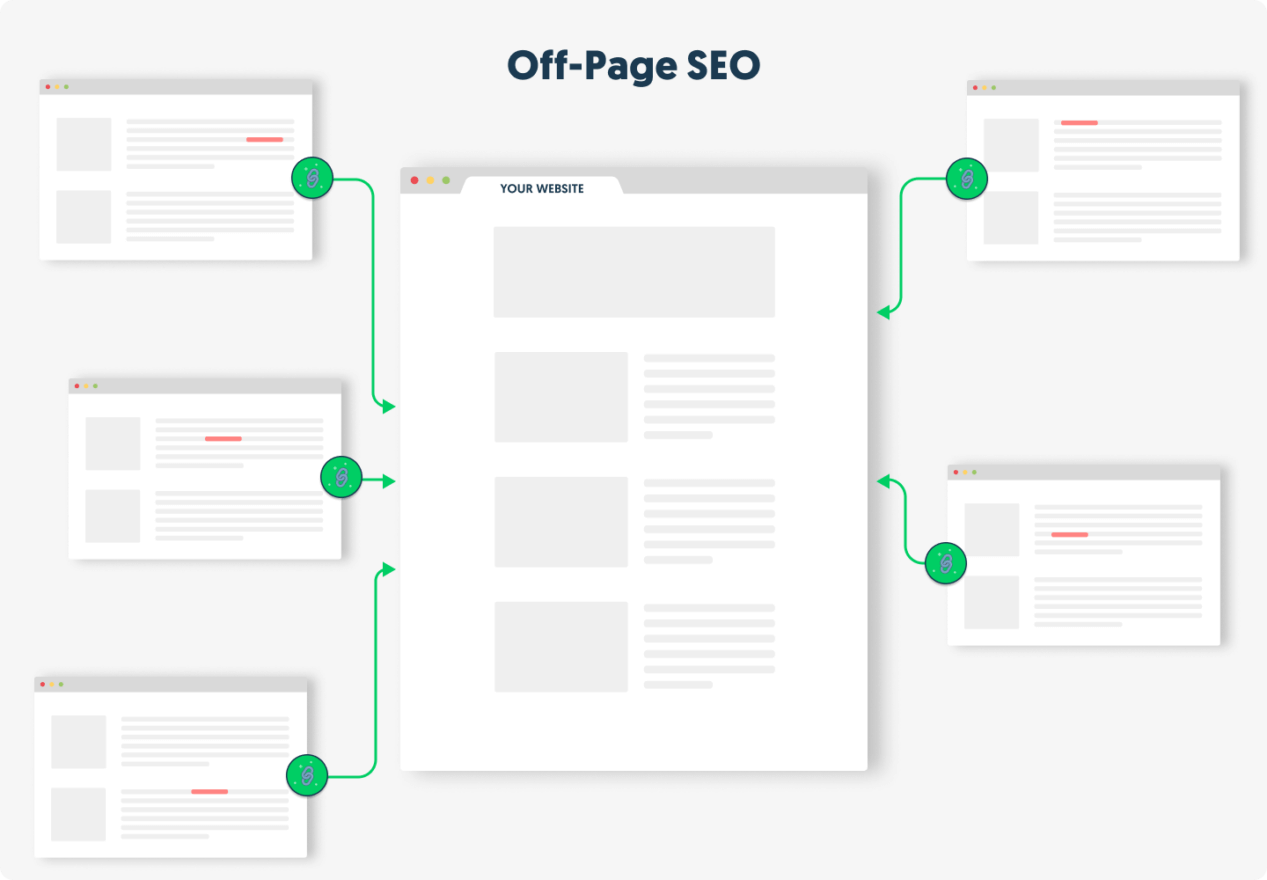
The second pillar related to SEO is off-page SEO (also called “off-site SEO”).
With on-page SEO, you optimize all the things you have control over on your website. With off-page SEO, it’s about the actions you take outside your own website, intending to improve rankings within the search engine results pages (SERPs).
The most common component for off-page SEO is building backlinks.
Search engines use backlinks to indicate the quality of the linked content. Thus, a site with many high-quality backlinks will usually rank better than another similar site with fewer backlinks.
Besides getting links from external websites, any activity you do outside your own website to improve your search ranking can be considered “off-page SEO.”
Other non-link-building things to consider are:
- social media marketing
- guest blogging on other websites
- influencer marketing
- using online directories such as Yelp, Google Company Profiles, etc.
Note: Actually, all these things are also a kind of indirect link building because surely the net result of all these activities is also that you somehow get a link referral to your site from another site on the Internet 😉 So the idea of “non-link related” off-page SEO is actually a bit of a misnomer.
Technical Optimization
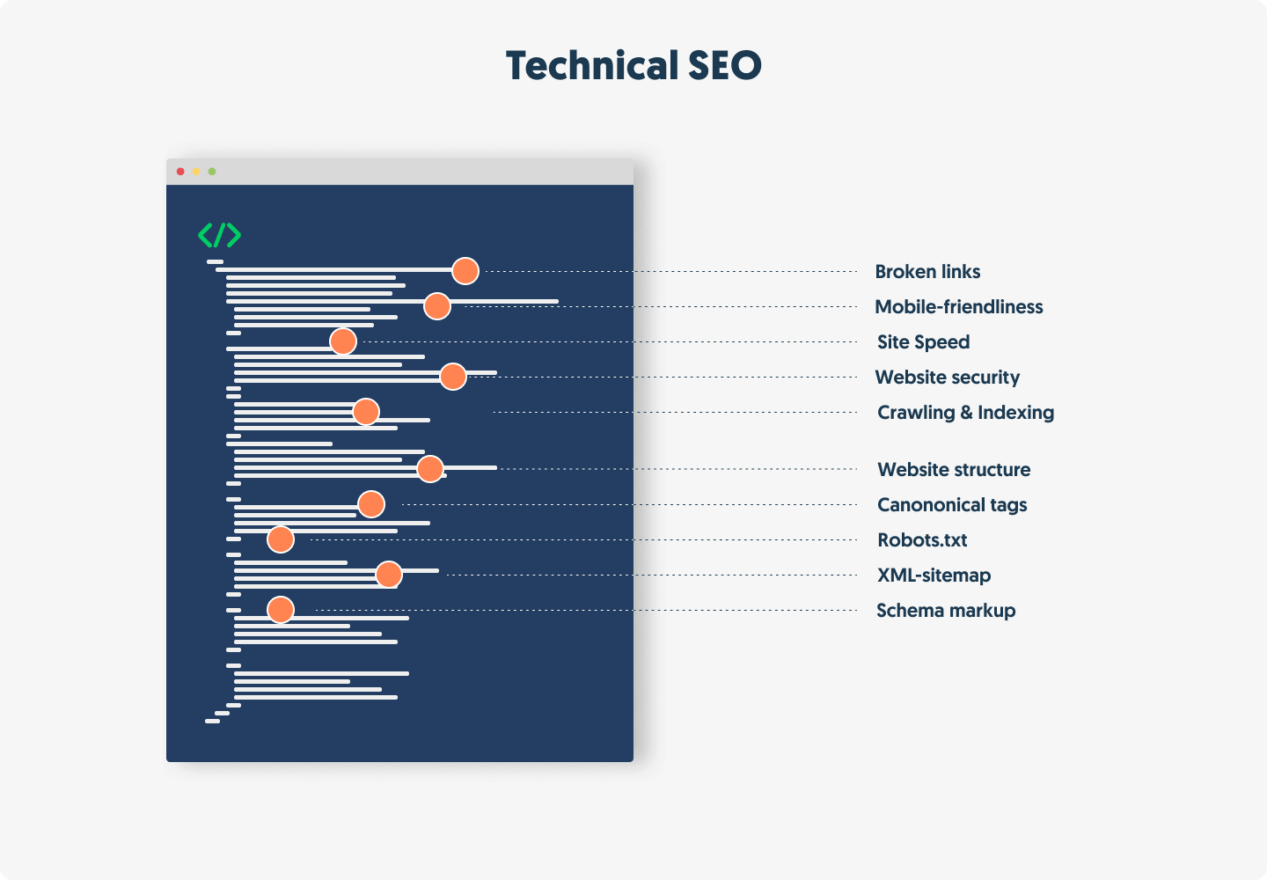
The final pillar of SEO is technical SEO optimization. As the name suggests, this is about optimizing all the technical aspects of your website to make it as easy as possible for search engines to crawl and index your website and ensure that the website is technically sound and meets search engine guidelines (such as Google’s search engine guidelines, or the Bing webmaster guidelines)
Things that fall under technical search engine optimization are:
- Site speed optimization: Site speed is a critical factor in SEO. Slow-loading sites can negatively affect the user experience, and search engines can penalize sites that take too long to load. You can optimize your site speed by compressing images, reducing HTTP requests, and using a content delivery network (CDN).
- Mobile-friendliness: With most internet users accessing the web on their mobile devices, websites must be mobile-friendly. This means the site should be optimized for display on small screens, have fast load times, and quickly navigate with a mobile device.
- Site architecture: Site architecture refers to the structure of your website and how pages are organized and connected. A clear and easy-to-navigate site architecture can make it easier for search engines to crawl and index your website.
- Robots.txt file: The robots.txt file gives instructions to search engine bots about which pages on your site to crawl and index. Setting up your robots.txt file correctly is essential to avoid blocking important pages or parts of your site.
- Formatting schema markup or structured data: Structured data is a way to label content on your site with specific tags that help search engines understand the content. By using structured data, you can improve your website’s visibility in search results and give users more context.
By focusing on these technical SEO optimization techniques, you ensure that your website is optimized for search engines and provides a better user experience for your visitors.
After all, Google’s bottom line is user satisfaction. If they can’t find the answer to the search query quickly, they will go to another place that can provide it.
Keyword research
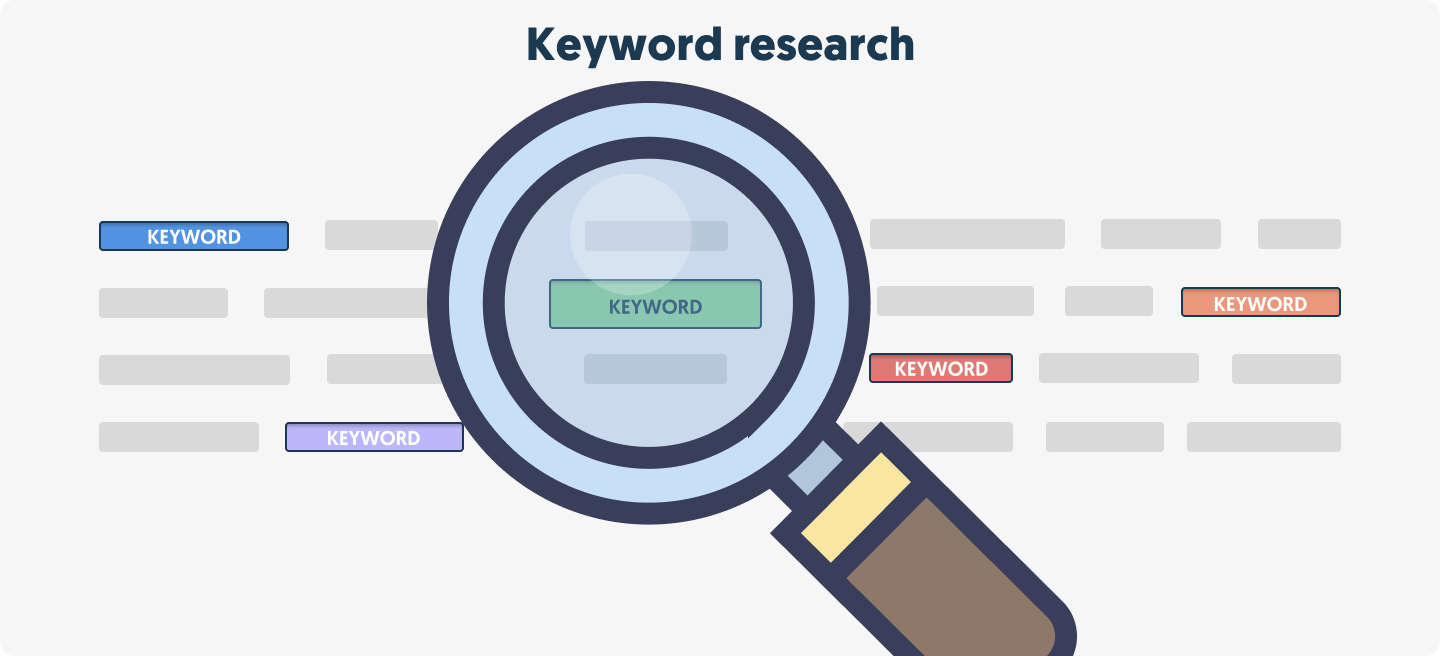
To create a successful SEO strategy, it is necessary to choose the right keywords. Finding the right keywords for your website will help target your content to the right audience and ensure a higher search ranking.
This section will discuss the importance of keyword research, how to find relevant keywords for your audience, and how to incorporate them into your content and SEO strategies.”
What is the importance of keywords for SEO?
So choosing the right keywords is one of the most important aspects of SEO. This is because keywords are the key to reaching your desired target audience. You can identify keywords that match your target audience’s interests and intentions by conducting keyword research.
Incorporating these keywords into your content and SEO strategies can yield higher rankings in search results and generate more organic traffic.
Using keywords that are not relevant to your content not only lowers the relevance of your page in the eyes of search engines but also for the user. This can lead to a higher bounce rate and less visitor engagement on your website.
By emphasizing keywords that matter to your brand and your target audience, you can strategically place your content to rank higher in search results. Using your keywords intelligently in your titles, content, and meta descriptions ensures that your content is better understood by search engines and more relevant to your target audience.
How to conduct keyword research?
To begin keyword research, you will first need to ask yourself what words people are using when searching when they are looking for a business in your niche. What are the words people use when they are looking for a solution to their problems that your product or service can help them with?
For starters, you can already break those questions down into product, business, and problem questions:
Product questions
- What are the products and services you offer? Take these words and combine them already with “best,” “cheap,” “compare,” “place name,” etc.
- What are essential words when people compare your product or service with another provider?
- Also, consider competing products or synonyms for your products
Ask if your company
- What do they call a company like yours? Your business may be called “Smart Bathrooms Inc.,” but you are a plumber at its core. Again, use combination words like “best,” “cheap,” “compare,” “city name,” etc.
Questions about the problems you solve
- What are the problems you solve for your customers? What are you helping them with?
- Why would your product or service be the solution to this problem?
- What questions do you often hear from customers before they purchase from you?
These questions will help you figure out what terms people use when searching for which your business should be found.
Be sure to check out our more in-depth article on keyword research.
Tips for selecting the right keywords
If you have a list of keywords, then it is time to select the best ones to get the quickest results. Keeping in mind the following five points:
- Understand your target audience: If you want to choose the best keywords, you must understand your target audience well and analyze their search behavior. This ensures that you address your target audience in the way they are used. That you ask them the right questions about their interests and the keywords they use to find your products, services, or information
- Use long-tail keywords: Obviously, every shoe retailer wants to be found on the term “buy shoes.” However, these types of words are hard to rank for, and your target audience also often uses much more targeted searches like “the best athletic shoes to run a marathon.” Using long-tail keywords can increase the chances of your content being found by the right target audience, thereby improving the quality of your search traffic.
- Analyze your competitors: You are not alone in the world, and even if you think you don’t have any competitors believe us, everyone has a competitor somewhere who is also grabbing the attention of your target audience. So look at how your competitors are targeting keywords. What words are they ranking for? This will give you a much better understanding of the keywords that are generating a lot of visitors, and you can, in turn, use those keywords to optimize your content.
- Choose relevant keywords: This sounds like a no-brainer, but make sure the keywords you use are relevant to your brand and the content on your website. Using non-relevant keywords can lead to lower rankings and fewer engaged visitors.
- Use plenty of variety: Not everyone uses the same word to describe a problem, so make sure to include different keywords and variations on keywords. By making clever use of variations, you can ensure that your website becomes more findable to a broader audience, and by doing so, you can also show that your content is diverse.
How to get started with on-page SEO optimization
Before we start optimizing your website’s on-page SEO, let’s double-check that Google can index your website at all. Otherwise, all the effort will be for nothing.
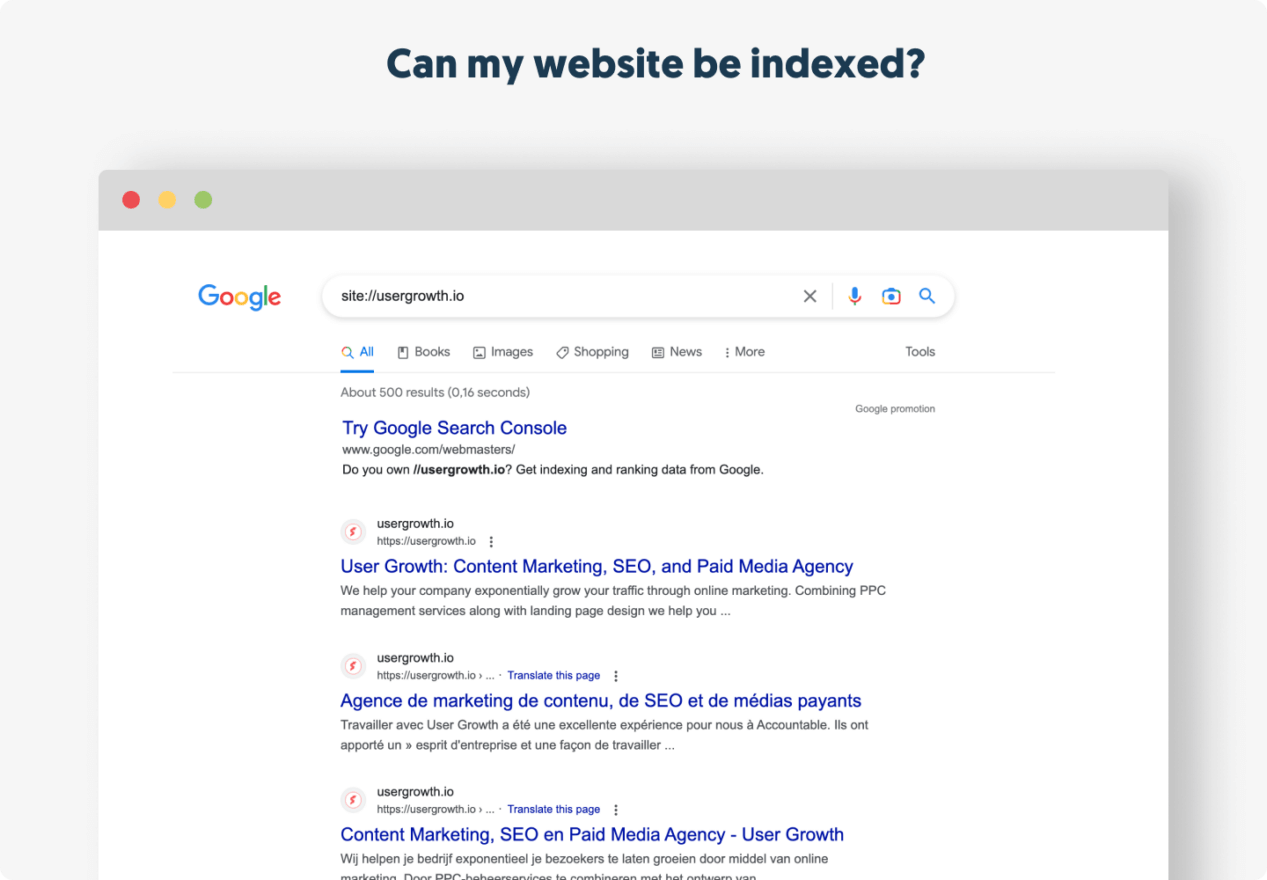
You can check this by going to Google and entering your website in the following way: “site://www.yourawesomewebsite.com” (or without www if your website is to be accessed without the www subdomain.
Next, do you see most of your pages listed? Then it looks like you’re good to be indexed, so high time to get to work on optimizing the various components, your on-page, off-page, and technical SEO optimization.
However, are you getting a message that no pages can be displayed? Then it seems that something is technically not quite right with your website. In this case, contact your website builder or your SEO agency for help. Otherwise, feel free to contact us as well.
Optimize title tags and meta descriptions
The title tag and meta description are crucial elements for on-page optimization. The title tag is the text that appears at the top of your browser window and is one of the main ways search engines determine the topic and relevance of your page. The meta description is the summary of your page that appears below the title tag in search results.
Here are some tips for optimizing it in advance:
- Use relevant keywords in your title tag and meta description.
- Keep the title tag under 70 characters and the meta description under 160 characters.
- Write attractive, descriptive, and unique title tags and meta descriptions.
If you want to go even deeper into optimizing your SEO title tags or meta-descriptions, check out our extensive articles on the topics in our academy!
URL structure optimization
URL structure is another critical on-page element that helps search engines understand the content of your page. Here are some tips for optimizing your URL structure:
- Use hyphens to separate words in your URLs
- Keep your URLs short and concise
- Use relevant keywords in your URLs
For a more comprehensive explanation of creating SEO-friendly URLs, check out our also complete article!
Optimizing headlines
Headers are one of the best ways to grab a user’s attention and convey the main topic of your page. Some tips to optimize your headlines for the reader and SEO:
- Use H1 tags for your main headline
- Use relevant keywords in the headline
- Keep your headlines short and sweet
Content optimization
Content optimization is all about creating high-quality, relevant, and valuable content that meets the user’s search intent. Where to start:
- Use relevant keywords in your content, but avoid keyword stuffing
- Optimize your content for readability and scannability
- Use bullet points, images, and videos to break up your content and make it more appealing.
Optimize internal linking
Before your content can be found, it needs links so search engine bots can see it.
Internal linking is linking to other pages on your website. It helps users AND search engines navigate your website and improves the visibility of your pages.
Internal links give search engines an idea of the structure of your site. They can create a hierarchy on your site, allowing you to provide the most important pages and posts with more link value than other, less valuable pages. So the right internal linking strategy can boost your SEO!
How to get the most out of your internal links for SEO?
- Use descriptive anchor text for your internal links
- Link to relevant pages on your website
- Keep your internal link structure simple and hierarchical.
How to get started with off-page SEO optimization
On-page optimization alone is not going to get you there. After all, anyone can shout on their website that they are the best, but you still have to prove this to the search engines. The best proof you can provide is external links—other people telling you how awesome you are.
This will make search engines see your website as more relevant than your competitor’s website.
You can’t always influence these things, but fortunately, there are some ways to help you.
Link building
As we discussed, most off-page SEO actually comes down to building links from external websites to your website.
High-quality backlinks are crucial to Google’s ranking algorithm and can directly impact your website’s search engine ranking.
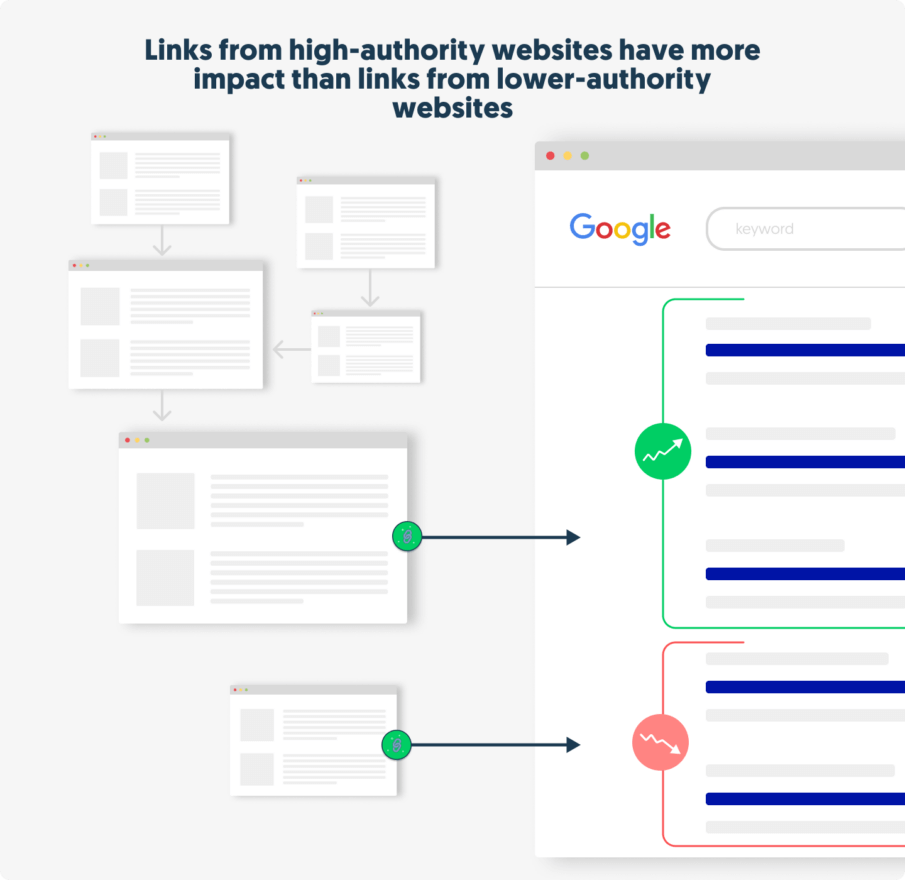
Some common ways to do this include:
- Identifying broken links on authoritative websites in your industry and approaching the website owner to suggest a replacement link to your website is a powerful way to acquire high-quality backlinks from high-quality backlinks.
- Creating and sharing informative infographics with other websites in your industry can help you build high-quality backlinks and improve your website’s search engine ranking.
- By using websites such as HARO, Terkel, and Qwoted.
Looking for even more link-building strategies? Be sure to check out our more in-depth article!
Social media marketing
By cleverly using social media marketing, you can get visitors from social networks to your website. However, don’t expect that creating an account and sharing links is enough to convince people to click.
You will need to develop a solid social media strategy that includes the following:
- Choose the right social media platform(s) for your brand and audience.
- Set specific goals for your social media marketing campaigns.
- Share high-quality, engaging content with your followers.
- Actively engage with your audience by responding to comments, posts, and mentions.
- Use social media ads to reach new audiences and convert them to your website.
Guest blogging
The last link-building tip we will share here is about guest blogging.
Guest blogging is a powerful off-page SEO tactic where you write and publish articles on other authoritative websites relevant to your industry and include backlinks to your website.
By providing valuable content to other websites in your industry, you can build your online reputation, attract more traffic, and increase your website’s domain authority.
Successful guest blogging in four steps?
- Identify authoritative websites in your industry that publish content relevant to your brand and audience.
- Research and follow the website’s guest blogging guidelines. Choose appropriate topics that align with your brand and the website’s audience.
- Write high-quality, informative, and engaging articles that add value to the website’s audience.
- Include backlinks to your website in the article and the author bio.
How to get started with technical SEO optimization
The final pillar of SEO is technical SEO. Technical SEO deals with all the things that are not directly visible to your website visitors. For example, think about optimizing:
Website speed
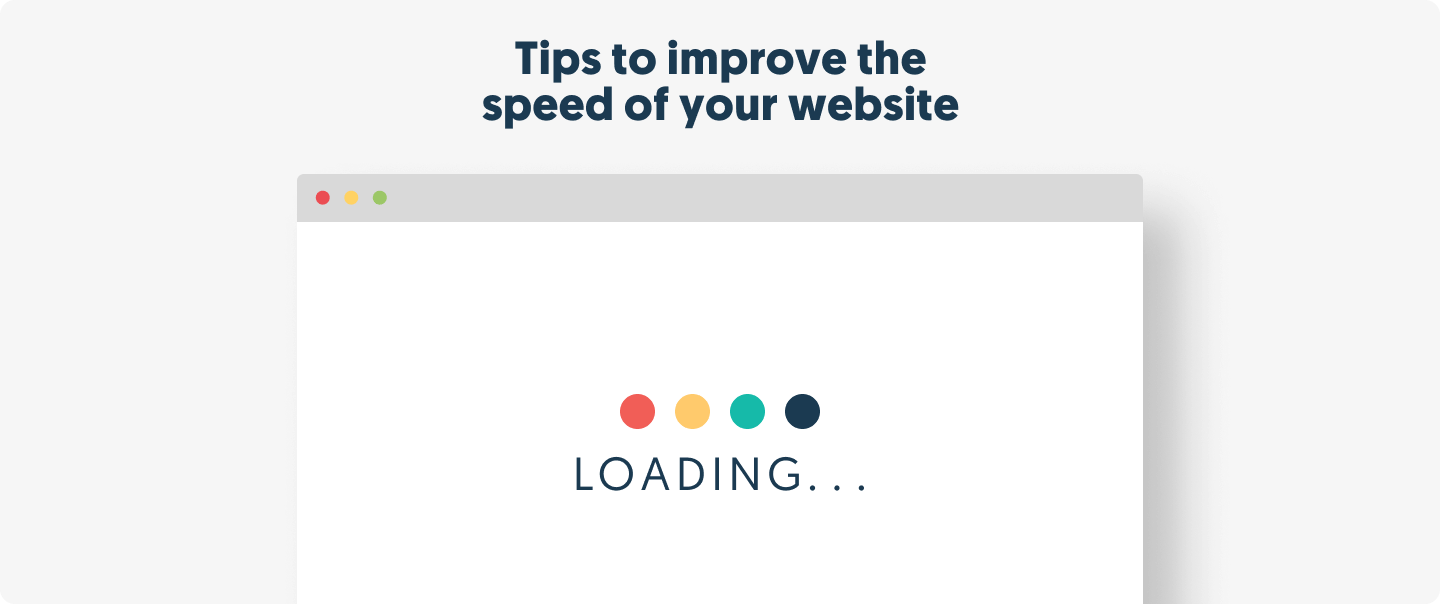
Remember how Google’s bottom line is user satisfaction?
Website speed is a critical element of technical SEO optimization. Slow website speed can increase bounces, decrease user engagement and negatively affect your website’s search engine rankings.
Here are some tips to improve your website speed:
- Optimize your images for web use
- Use a content delivery network (CDN)
- Minimize HTTP requests
- Use browser caching
- Remove unnecessary plugins and scripts
Mobile-friendliness
If your website was built after July 1, 2019, then by default, it is indexed as if it were viewed via mobile. All other websites have also switched to the so-called “mobile-first index” since 2021.
And that makes sense, so, with more than half of the traffic coming from mobile devices, it is critical that you design and create your website with someone on a mobile as the primary user.
So make sure you:
- Use responsive web design to ensure your website adapts to different screen sizes.
- Use large and readable fonts.
- Compress images for faster loading time.
- Ensure your website has a mobile-friendly layout, easy navigation, and a clear information hierarchy.
XML Sitemap
The XML sitemap is another essential technical SEO optimization. An XML sitemap shows the structure of your website, including the URLS, pages, and content that search engines can crawl. Here are some tips for optimizing your XML sitemap:
- Keep your sitemap up-to-date with all website changes.
- Make sure all URLs on your website are included in the sitemap.
- Include an XML sitemap in your robots.txt file and submit your sitemap to Google Search Console.
Robots.txt
Before we started optimizing your site for SEO, we first looked at whether your site could be indexed. If it wasn’t, then chances are it’s because of your robots.txt.
Such a harmless-looking file, but with such a huge impact.
You see, the robots.txt is a file on your website instructing search engines how to crawl and index your website. One mistake in this and your entire website cannot be crawled or indexed. So:
- Ensure your robots.txt file is up-to-date and reflects the latest changes to your website.
- Include instructions that allow search engines to crawl and index your website’s most important pages.
- Use the “disallow” directive to block search engines from crawling irrelevant pages or parts of your website that you don’t want to be indexed.
What tools do you need and can you use for search engine optimization?
With using tools for SEO, you can go as crazy as you want, as long as you have a budget to pay for them 😉
Fortunately, there are also a lot of tools that cost nothing or next to nothing, so even the beginning SEO’er with little to no budget can get started anyway.
If you start using these tools, it will probably make your life a lot easier, leaving you more time to optimize or create content that will rank.
Ubersuggest
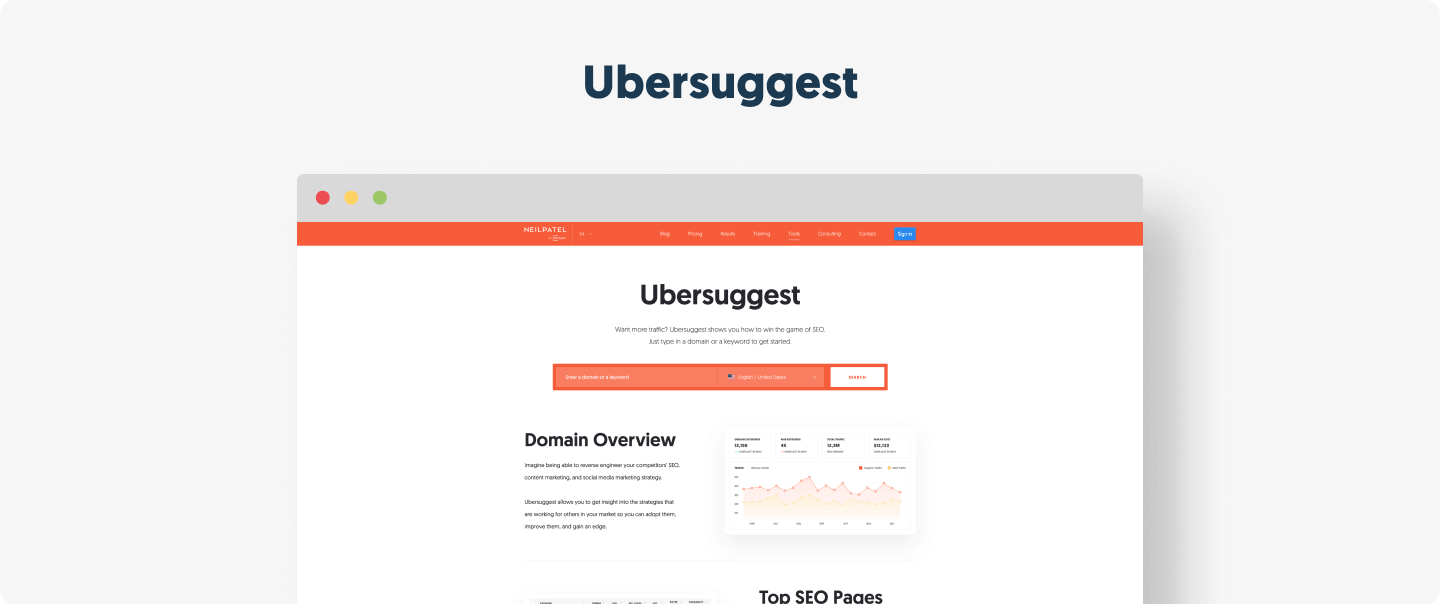
SEO falls and stands with starting and doing good keyword research. And although most tools such as ahrefs, semrush, or SE Ranking are paying, there is also a free alternative you can use to get started for your keyword research: Ubersuggest.
With it, you can only run three free searches a day, but it’s better than nothing!
Answer The Public
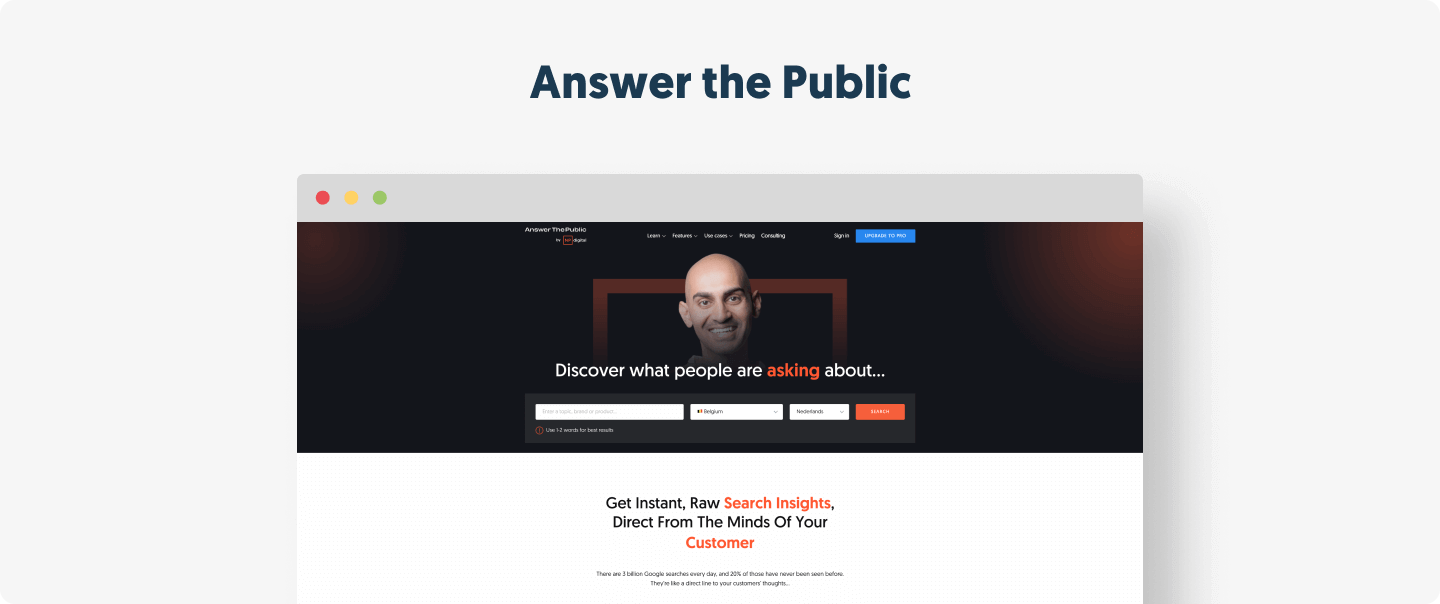
Another free tool that can help with keyword research, that was recently acquired by the maker of Ubersuggest: Answer the Public.
Answer the Public gives you insights into your target audience’s questions about a particular topic.
So this way, you can start writing content that fits well with the searcher’s questions and expectations.
Screaming Frog
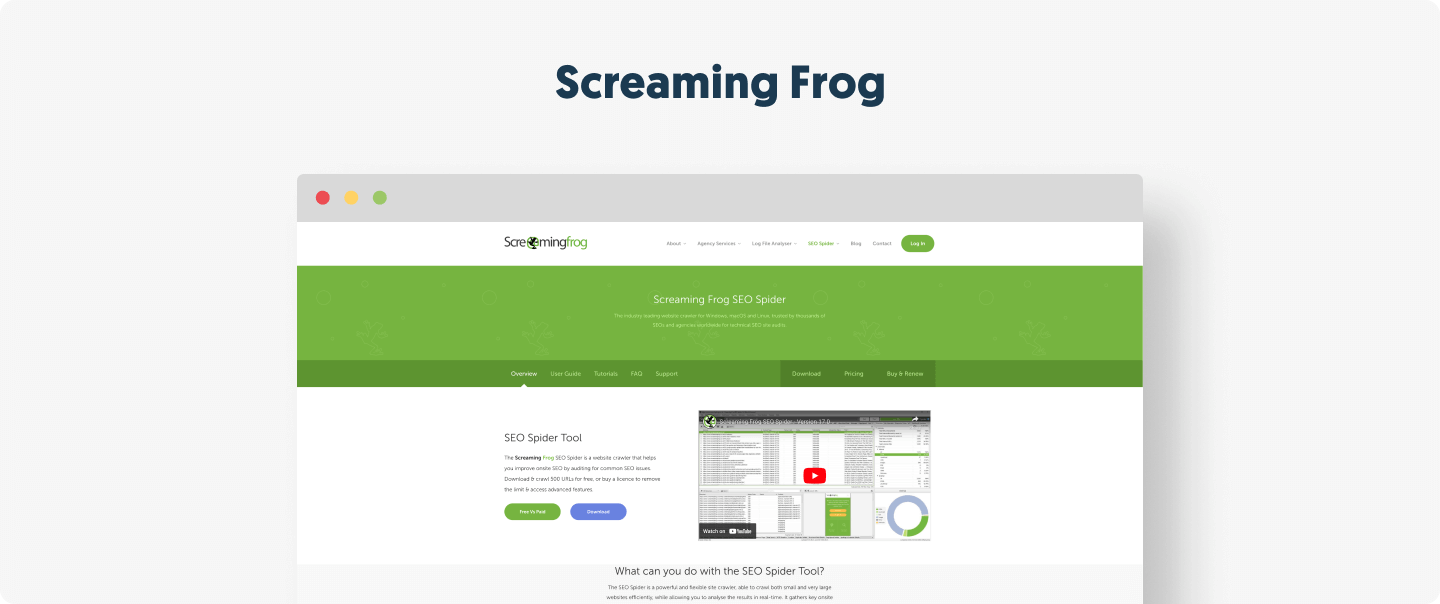
Screaming Frog is a crawler, just like search engines do on your website, and can show you the results clearly.
It allows you to quickly and easily identify technical problems, such as which images are too heavy, which pages are not working, which pages have no titles, etc.
Although Screaming Frog has a paid option, it has a free version that can crawl up to 500 URLs. So an ideal tool if you are starting out and only have a small website.
Google Analytics

Google Analytics, most marketers among us will indeed have at least heard of it. It is a tool that shows what visitors do on your website, how they get back there through which channels (organic, paid, and social media, for example), and also which pages are the most popular.
Google Analytics is a handy tool to see if all your efforts are leading to more visitors.
Google Analytics is free to use when you have a Google account.
Google Search Console
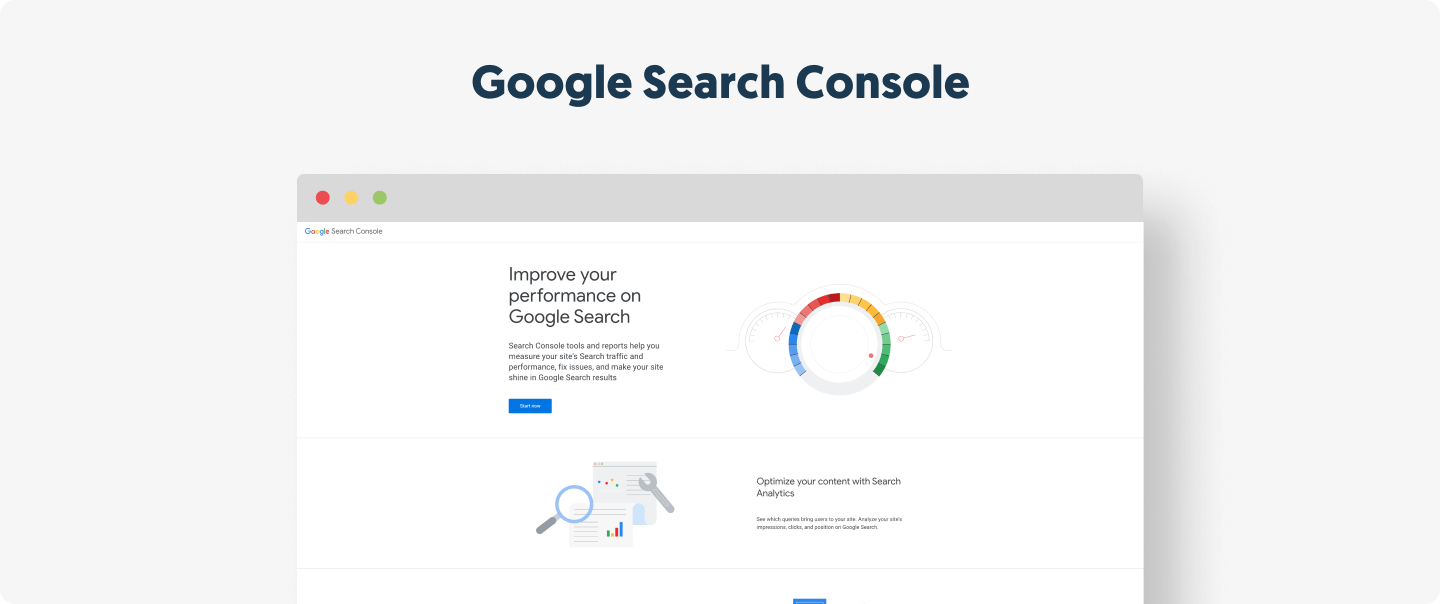
Whereas Google Analytics shows what visitors do on your website and where they come from, Google Search Console lets you see what happens within the search engine BEFORE someone comes to your website.
For example, you can see what search terms your website can be found for and see if there are any problems crawling and indexing your website.
You can also share your XML sitemap, for example, or tell Google that you have put a new page live on your website to index it faster.
Google Search Console is free to use when you have a Google account.
Google Tag Manager
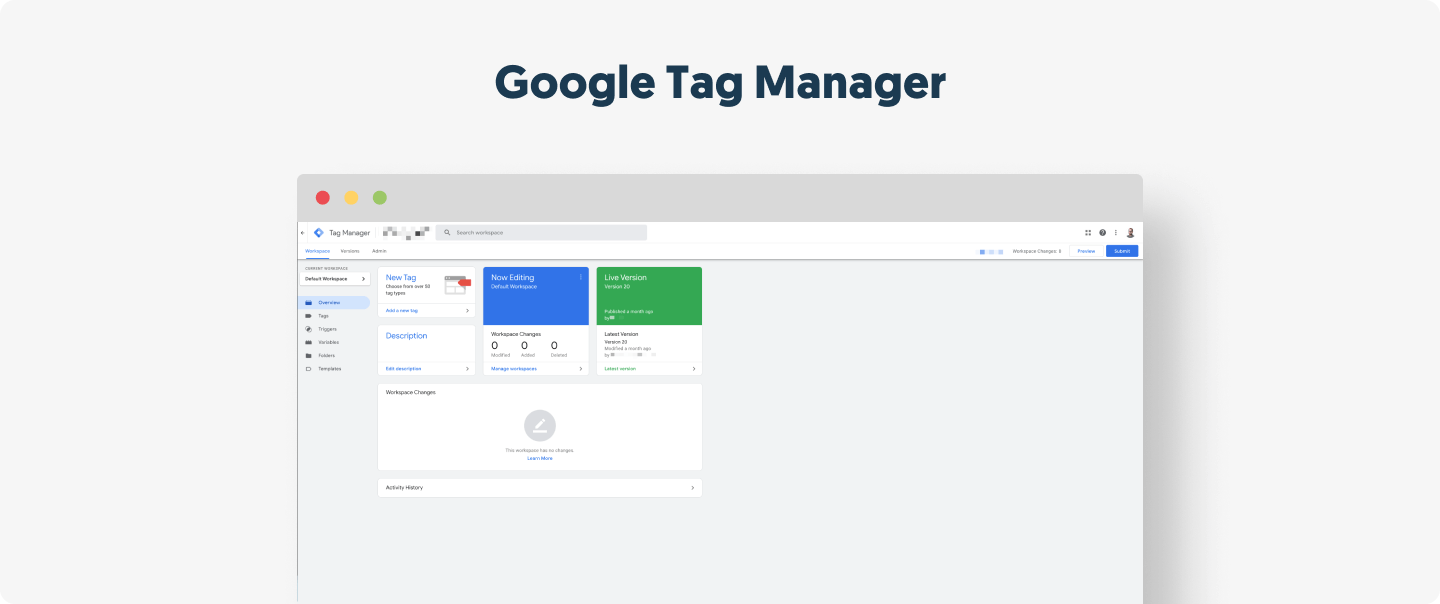
All external things that require a piece of code to work on your website offer a “tag.” A piece of code that allows them to do their job.
Google Analytics, the famous Facebook Pixel, etc., are all examples of tags.
Generally, if you want to place pieces of code on your website, you must ask your developer to do this every time. But of course, this can be done easier! Have your developer add the Google Tag Manager code once, and you can then place the tags in the tag manager container on your website yourself.
In addition, you can also quickly work out a tracking plan for your website so that you can track exactly how many conversions you actually have. Google Tag Manager is definitely going to save you time and money.
Google Tag Manager is free to use when you have a Google account.
Google Business Profiles (or formerly known as Google My Business)
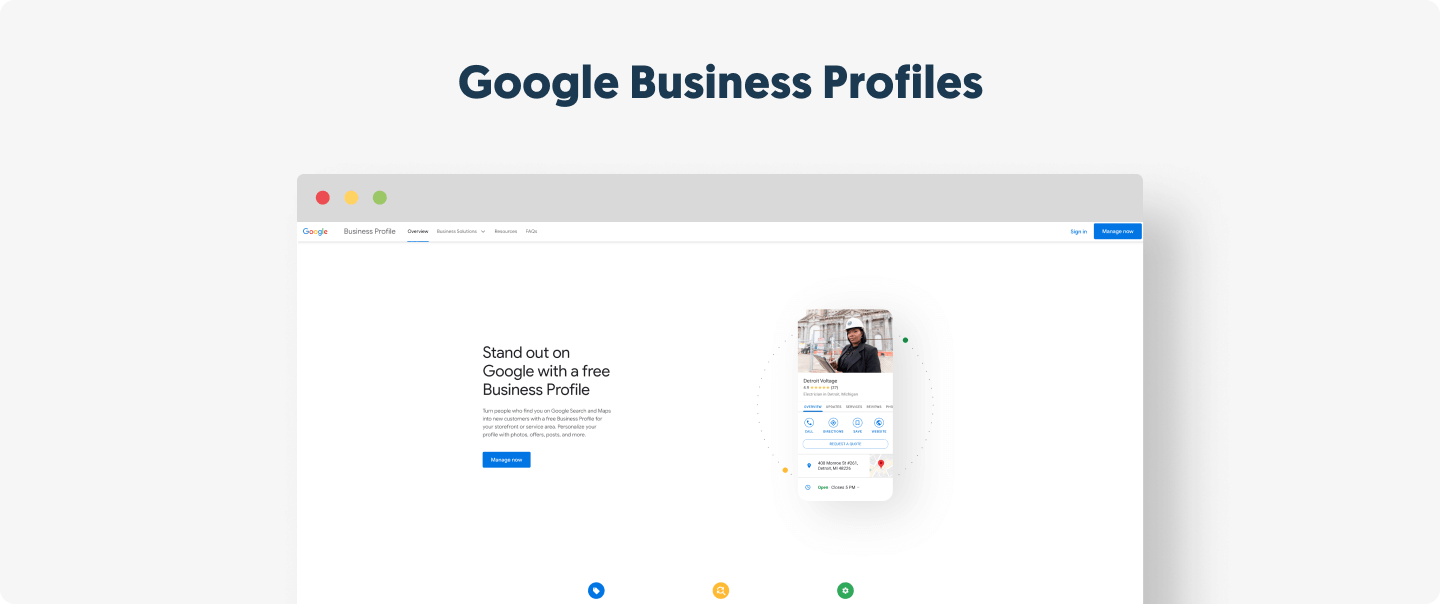
Not necessary for all businesses, but if you have a company with a physical location where you can host people or you are, for example, a service provider that comes to people’s homes (for example, a plumber), then signing up your business to Google Business Profiles is definitely recommended.
This makes your business more visible in search results and on Google Maps.
In other words, a free tool that will get you found faster!
RankMath or Yoast SEO (for WordPress)
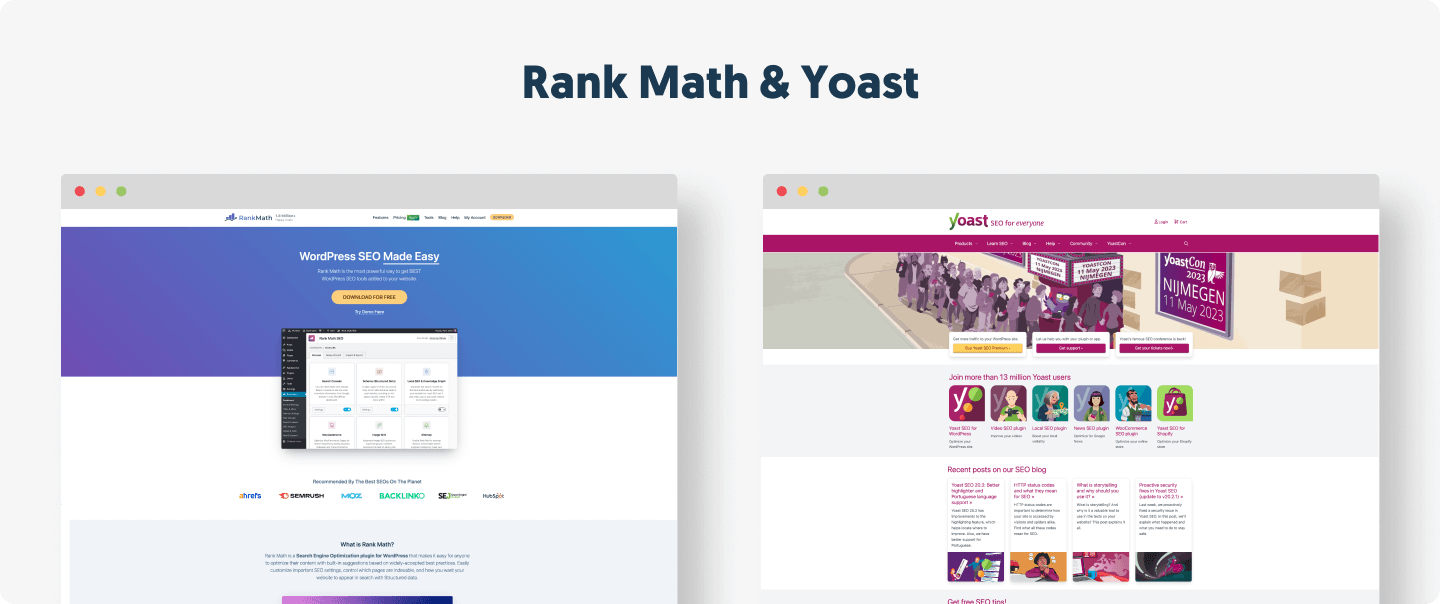
Are you one of those millions of websites that uses WordPress as the CMS for your website? (You probably are, since 43.2% of the Internet uses WordPress). Then it’s definitely recommended to install a plugin like RankMath or Yoast SEO. It takes a lot of tasks (like creating a sitemap, quickly creating meta-descriptions, etc.) off your hands, making a lot of SEO optimizations a lot easier.
Both are free but also offer premium versions.
Frequently asked questions about SEO
How much does SEO cost?

A question we often hear is how much does SEO really cost? The great thing is SEO itself costs nothing. And that immediately makes it a big difference from SEA, or Search Engine Advertising.
All the things discussed in this article cost nothing. Making the adjustments on your website, if you can do it yourself, it’s free. Writing content, that’s free. You don’t need ad budgets for that.
But you’re obviously paying for the hours you spend doing this. When you’re busy executing your SEO strategy, you can’t do other tasks in your business. Or you outsource these tasks to our SEO specialists, who can easily take the work off your hands.
The added benefit, if our SEO specialists do your search engine optimization, then you can be sure that it will yield more than you will pay for it because it is a long-term investment from which you will see success for years to come.
What will SEO bring me?
Another frequently asked question. If you have proper tracking and conversion measurement installed on your website, you can correctly measure how many of your organic visitors convert to customers.
But the success of this also depends on the intensity with which you are engaged in SEO and whether the work is done correctly.
You may not see immediate results because, unlike Google Ads, it takes a while for all your efforts to be properly indexed. The number one position on Google didn’t come overnight here either, and so if you want to take over that position, it will take some time.
How long does it take to see results from my SEO efforts?
Like so many answers in marketing, “it depends.” The short answer to the question is usually between 4 and 12 months.
The longer answer concerns all the factors discussed in this article—the aspects related to your SEO strategy.
If you work in a niche with little competition, you can start seeing results within 4-6 months.
Measurable increases in visitors and conversions should start to show up by then, but it may take longer in some cases.
If you want to start competing for keywords with a lot of competition and high domain and page authority, it can take much longer, and sometimes as long as a year, to start seeing solid results.
That’s why we always recommend starting with the low-hanging fruit first, so you can already start seeing results a little faster.
In addition, of course, you must also keep in mind that a good SEO strategy continues to evolve and adapt to changes in search engine algorithms.
What are the main components of search engine optimization?
Search engine optimization has three main pillars:
- On-page SEO: all the content of your website. The information that is directly visible to the visitor
- Off-page SEO: authority or the external factors that tell the search engine how reliable your website is by linking to it
- Technical SEO: the things that are not directly visible to the visitor, site structure, structured data, fast loading time, etc.
What are “white-hat” and “black-hat” SEO?

You may have heard the term “white-hat” SEO and not know what exactly it means. A “white-hat” SEO’er does things like search engines want you to do. They are focused on the visitor and, therefore, of high value.
“Black-hat” SEO, on the other hand, tries to get into the search engine as quickly and as high as possible through all kinds of tricks and unethical practices. They try unfairly manipulate or “trick” Google’s and other search engine algorithms to create artificially improved results.
This can give quick results but can be hugely punished by search engines. Some well know black-hat techniques include things like keyword-stuffing, invisible texts, PBNs (Private Blog Networks), etc. Identifying these techniques is a major focus for search engines as it strives to exclude any web content that uses them. Black hat techniques should be avoided.
Should I hire an SEO specialist, consultant, or agency?
Again, it depends a bit. How complex is your website? Most of the basic principles discussed in this article and others in our academy may be easy to pick up independently.
If you’re just a little less technically savvy, having an SEO specialist looking over your shoulder and providing you with advice might be nice.
So be sure to take the time to go through all of our content. After that, would you like us to look over your shoulder or take specific work off your hands? Then you can always reach out to us!
Getting started with SEO yourself?
SEO is an essential part of any digital marketing strategy that allows you to increase your online visibility and bring in more visitors and revenue.
As you can see, the SEO landscape is a diverse environment with many different possibilities. By following the best practices from this article and applying the right techniques, you’re already one step closer to that number one position, and you’re definitely going to rank higher in search results than your competitor who doesn’t engage in this.
So don’t wait until tomorrow and get started today by applying the tips and strategies in this guide, and watch your website visibility skyrocket!
Want to make sure you address the right priorities first? Then get in touch for an SEO audit!